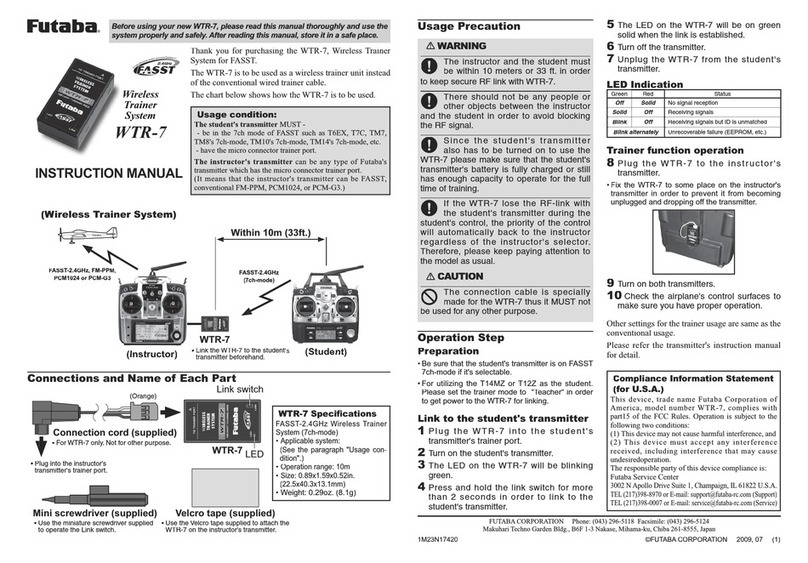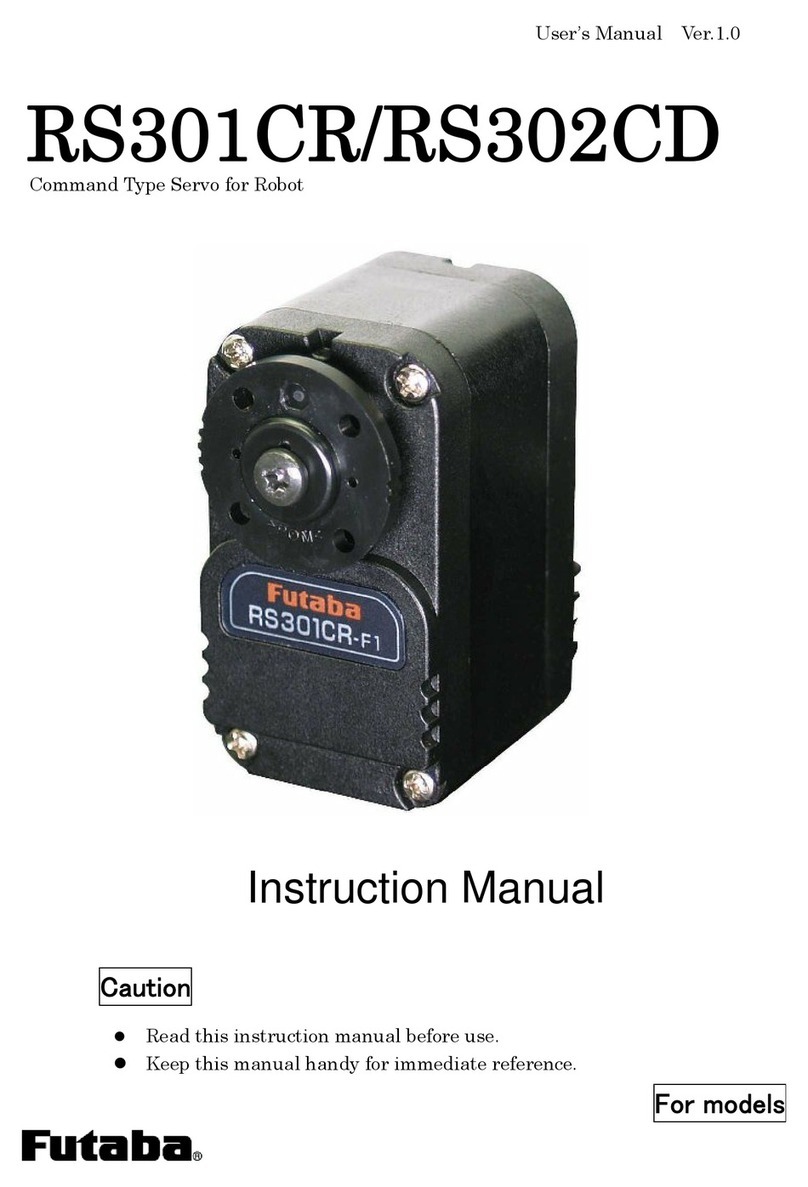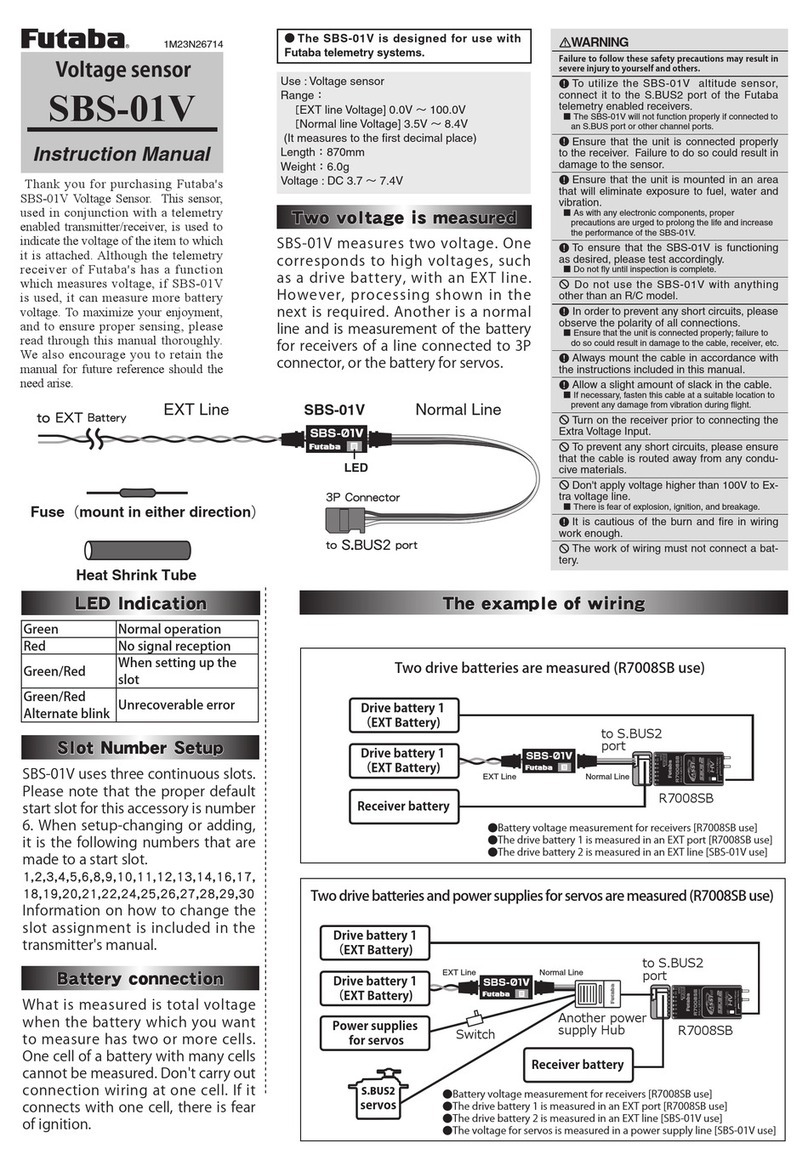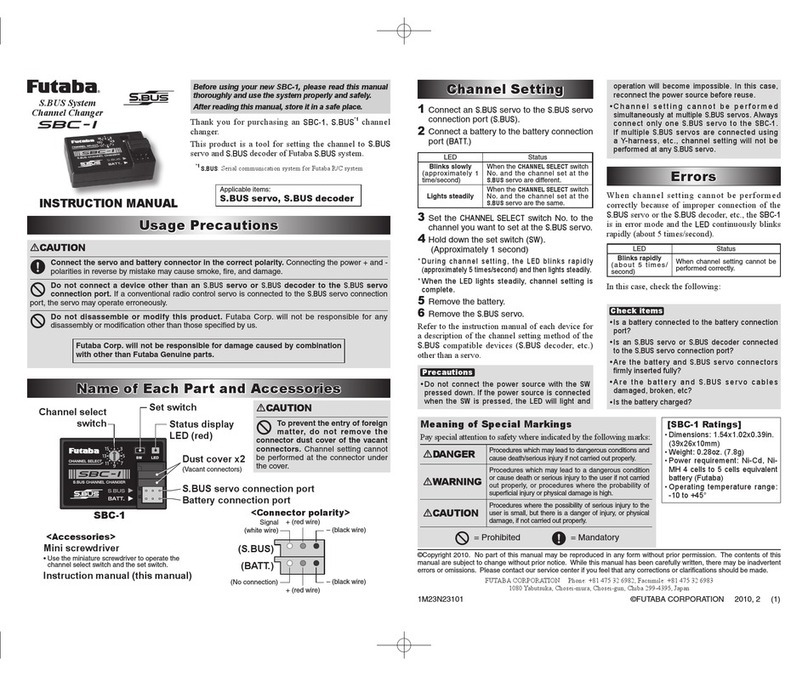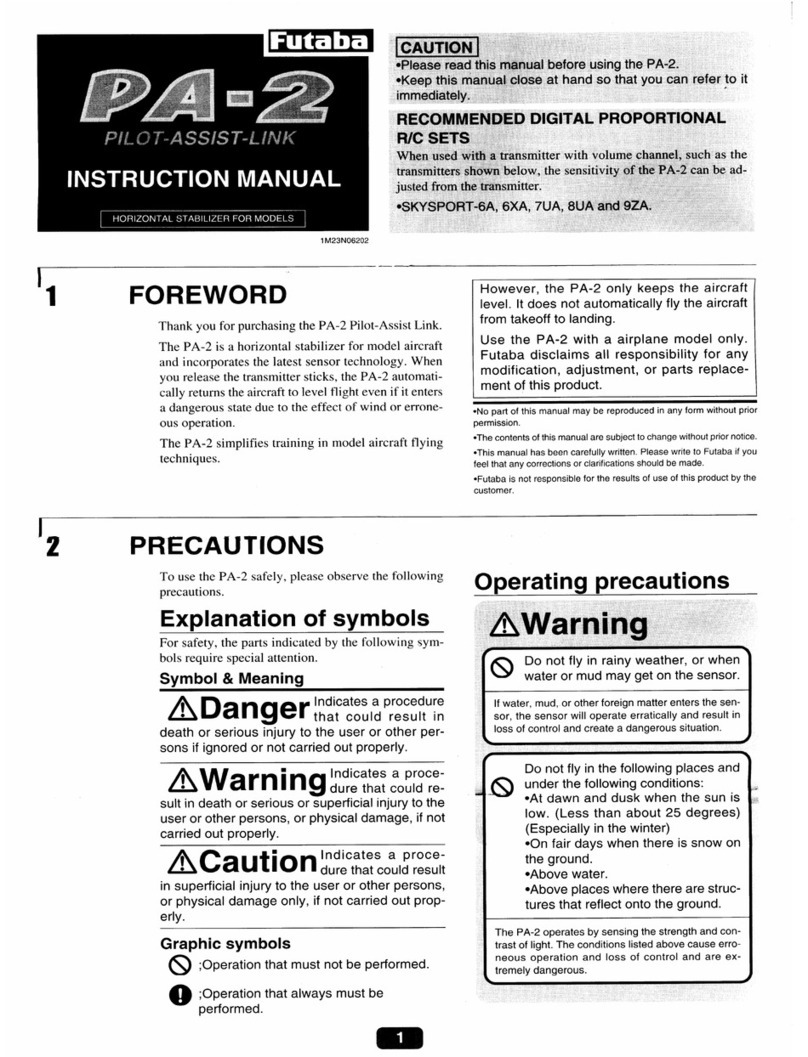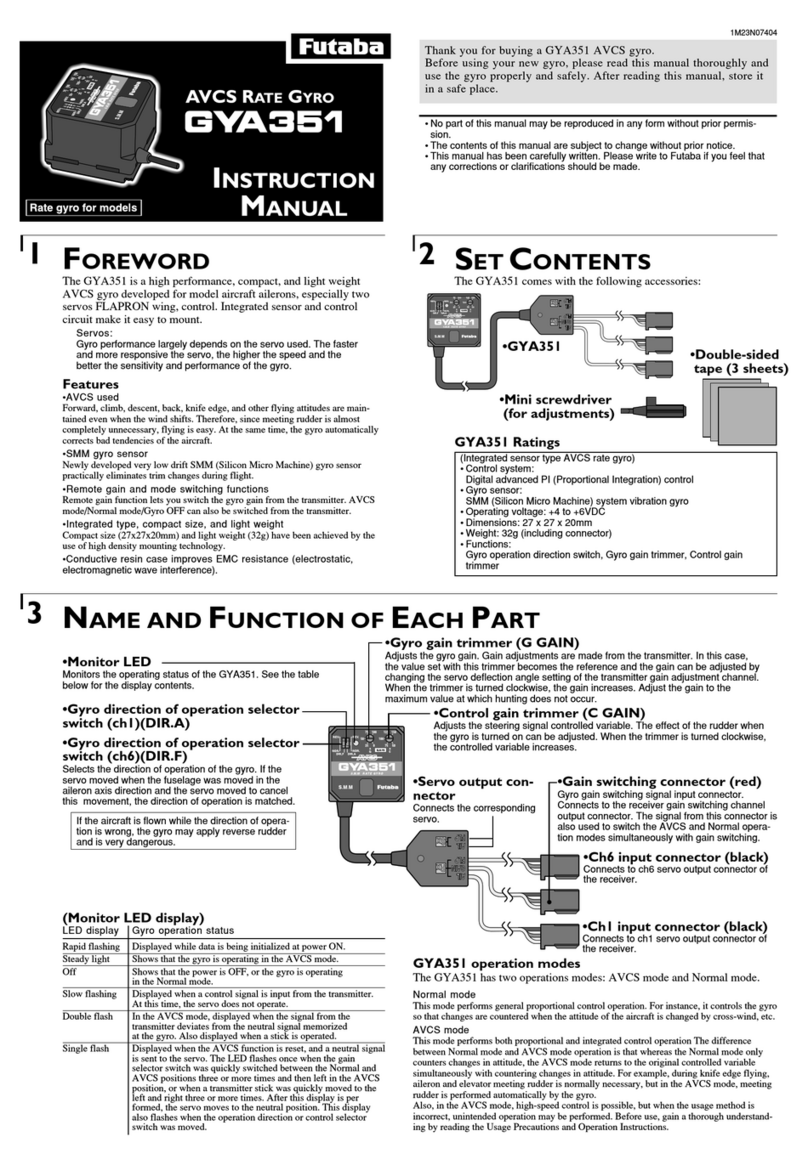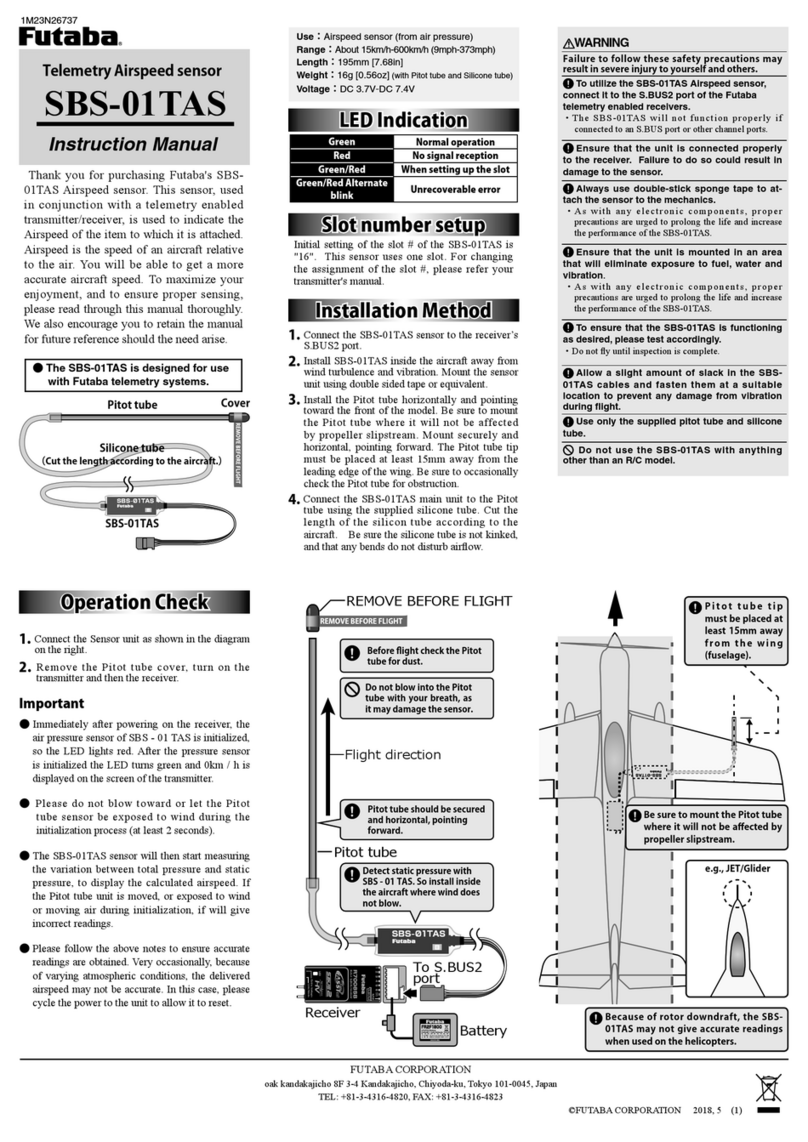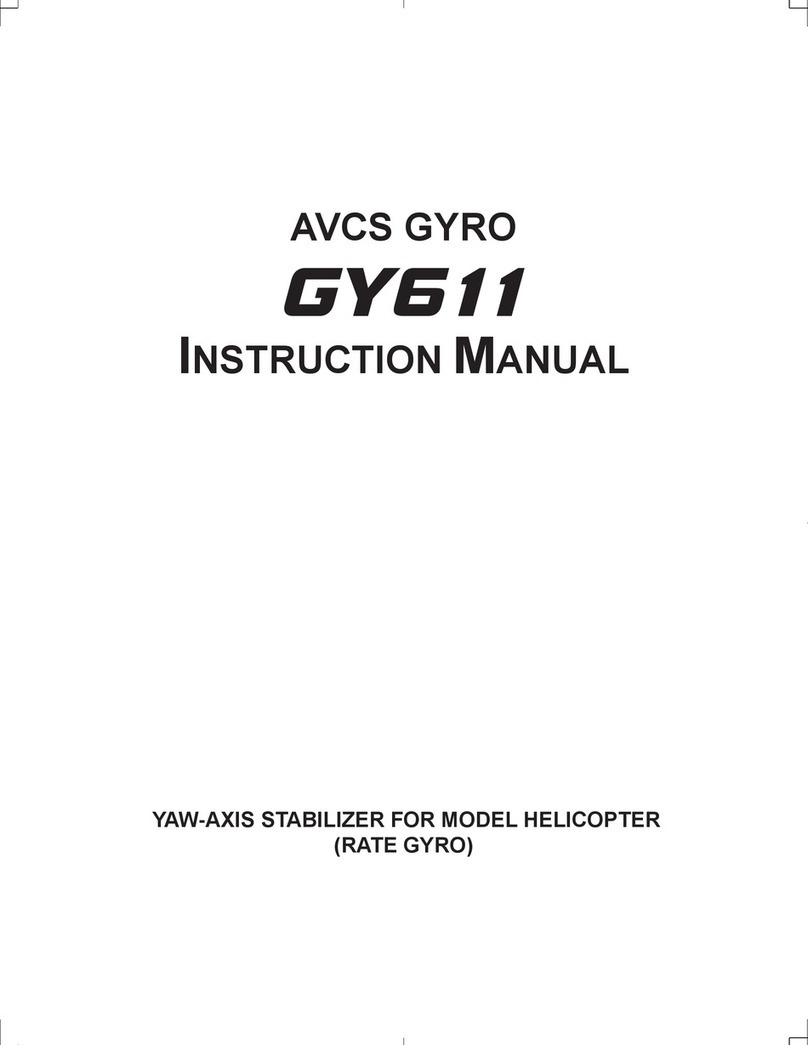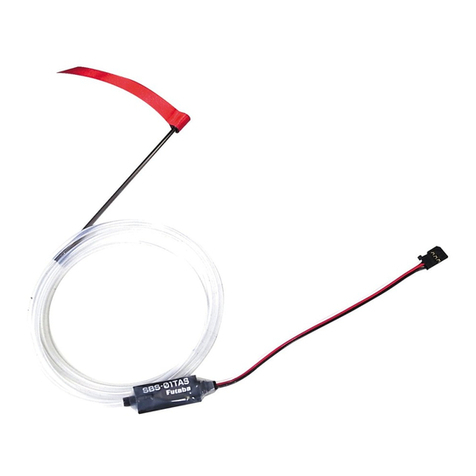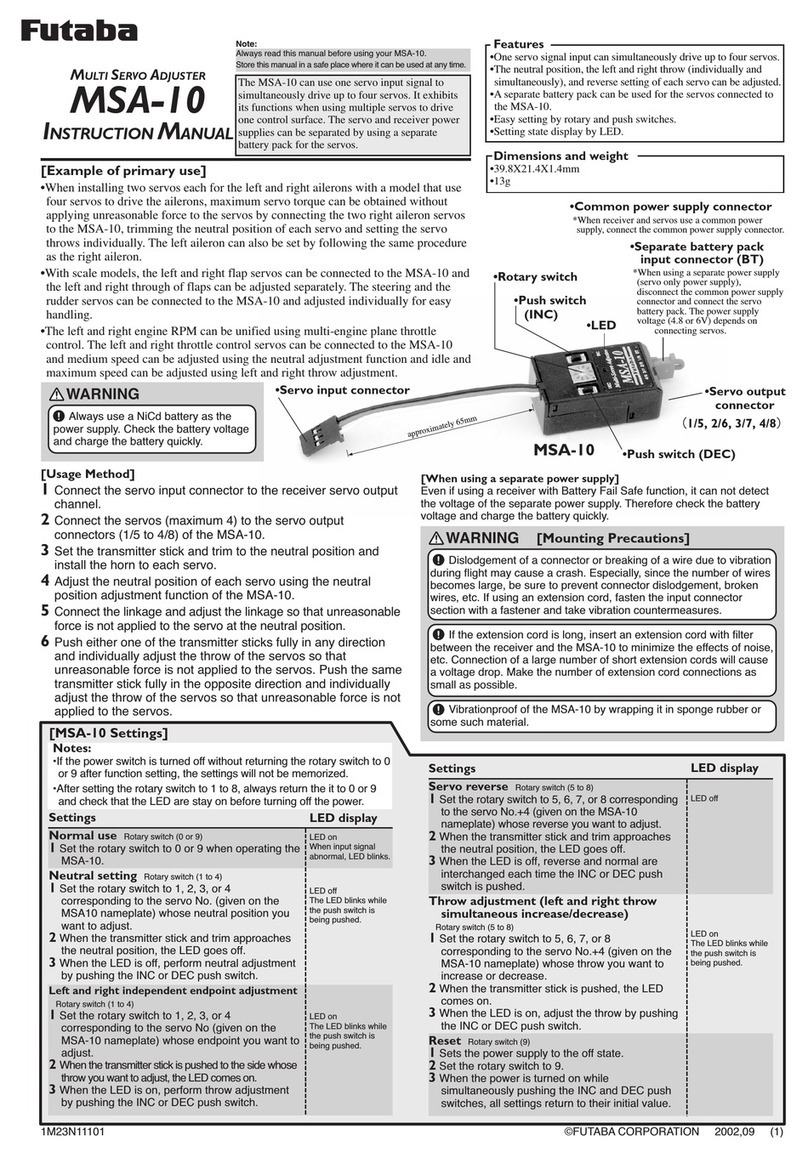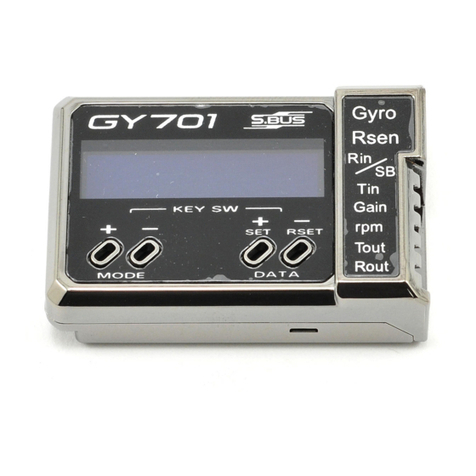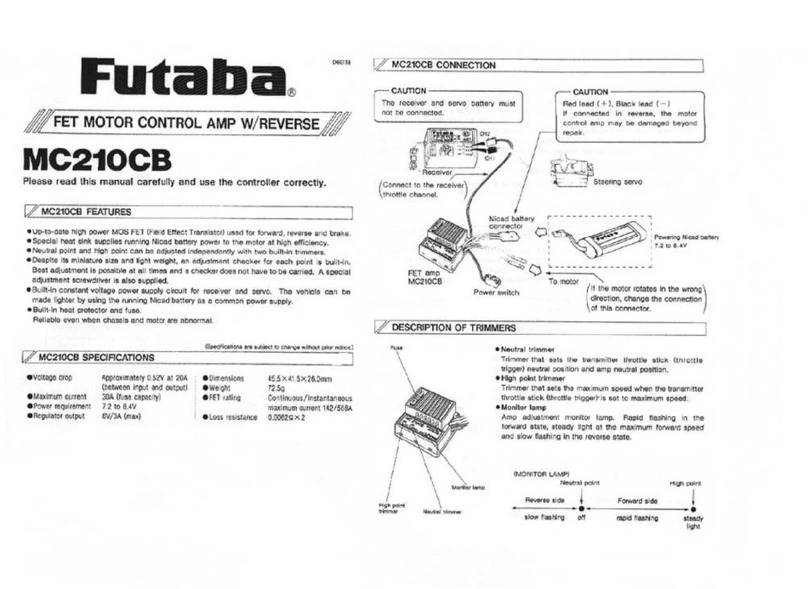Control gain
trimmer (C GAIN)
Flight adjustment
1. Power ON procedure
Turn on the transmitter power, then turn on the receiver and gyro power.
Initialization is performed automatically for about three seconds after the
gyro power comes on. Do not move the aircraft during this period.
2. Trim adjustment
Set the gyro gain switch to the Normal or OFF position. The monitor LED
goes off. Fly and trim the aircraft in this state.
When the mechanical deviation is large, correct the linkage. Connect the
linkage so that the servo horn and transmitter trims are in the center
position.
3. Gyro gain adjustment
When the servo hunts, the gyro gain is too high. Lower the gyro gain until
the hunting stops. The gyro displays top performance at a gain just before
hunting begins. Perform trimming by flying the aircraft repeatedly. Adjust
the gain by raising and lowering the transmitter ATV or mixing rate.
4. Rudder effect adjustment
Use the transmitter deflection angle adjustment function to
adjust the rudder effect.
However, when the rudder effect is substantially different
from that when the gyro is installed, adjust it using the control
gain trimmer.
When the gyro is turned on, the rudder will feel sluggish. Adjust the
control gain to match the rudder effect when the stick is set to its maxi-
mum position. When the control gain adjustment amount increases, the
rudder effect increases. Adjust the linkage so that use is possible at a
transmitter deflection angle setting of 70% or more.
5. AVCS side neutral data memorization
The neutral data can be memorized by following process. After landing the
aircraft, set the rudder stick to the neutral position and rapidly switch the
transmitter gain switch between the AVCS and Normal positions at least
three times at an interval of within one second and then set the gain switch
to the AVCS position. In this case, the monitor LED flashes once to show
that memorization is complete. The neutral data can also be memorized by
setting the gain switch to the AVCS position and turnning on the gyro
power again. When using flight conditions, verify that the gyro monitor
LED lights under all the flight conditions used. If the LED flashes twice,
trim of that flight condition has changed. Repeat transmitter trim adjust-
ment. This ends AVCS side setting.
6. Switch to the AVCS or Normal mode, as desired.
In the AVCS mode, meeting rudder is seldom necessary because trim
changes during knife edge and upside-down flight are compensated for by
the gyro. Conversely, when the aircraft enters a stall condition in the low
speed state, the gyro continues to apply correction rudder and the aircraft
may enter an unintended attitude. To avoid stalling in such a state, return
to normal attitude as soon as possible by increasing engine power and
applying reverse rudder, or switch the gyro to the Normal mode.
Fuselage Maintenance
Precautions
Do not turn the sensitivity trimmer with
too much force.
The trimmer may break. Always use the miniature
screwdriver supplied to make adjustments.
Service the fuselage with a little vibration
as possible.
Fuselage vibration has a very adverse effect on gyro
performance.
Mounting Precautions
Always use the accessory sensor tape to install
the gyro to the fuselage.
This is necessary to securely fasten the gyro to the fuselage
so that operation of the gyro does not transmit unwanted
fuselage vibrations directly to the sensor.
When mounting the gyro, provide a little
surplus so that the gyro connection cables
are not too taut.
If the gyro cables are too taut, the gyro will not display its
full performance. If the gyro peels, control will be lost and
result in a dangerous situation.
When using the gyro with a airplane, install
the GYA352 at least 10cm from the drive
motor and at least 2 cm from the servo.
The drive motor etc. generates strong electromagnetic
noise. This noise may interfere with the gyro sensor and
cause erroneous operation.
Mount the GYA352 so that metals or other
conductive objects do not touch the gyro
case.
The GYA352 uses a conductive resin case to reduce
electromagnetic interference. Because the surface of the
case is conductive, metal objects may cause a short circuit.
Insert the connectors fully.
If a connector works loose due to vibration during flight,
control may be lost and result in a dangerous situation.
Always check the direction of operation of
the servos.
If you attempt to fly the model when a servo operates in the
wrong direction, the fuselage will spin in a fixed direction
and enter an extremely dangerous state.
Operation Precautions
Never move the fuselage for about 3 sec-
onds after turning on the gyro power. (when
using in the AVCS mode)
Since the data inside the gyro is automatically initialized
as soon as the power is turned on, if the fuselage is
moved, the neutral position will change. If this occurs,
turn the power off and on again. When turning on the
power, set the transmitter switch to the AVCS position
FUTABA CORPORATION
Makuhari Techno Garden Bldg., B6F 1-3 Nakase, Mihama-ku, Chiba 261-8555, Japan
Phone: (043) 296-5118 Facsimile: (043) 296-5124
Special Markings
Pay special attention to the safety at the parts of this manual that are indicated by the following marks.
Mark Meaning
Procedures which may lead to a dangerous condition and cause death or serious injury to the
user if not carried out properly.
Procedures which may lead to a dangerous condition or cause death or serious injury to the
user if not carried out properly, or procedures where the probability of superficial injury or
physical damage is high.
Procedures where the possibility of serious injury to the user is small, but there is a danger of
injury, or physical damage, if not carried out properly.
Symbol: ; Prohibited ; Mandatory
When using the gyro in the AVCS mode,
turn off mixing.
For example, if elevator down mixing is used by the air
brake, the gyro will judge that an elevator down signal
was received and will cause the aircraft to dive. In the
AVCS mode, the gyro automatically changes the trim
and, therefore, these mixings are unnecessary. When
mixing is necessary, set so that the gyro enters the
Normal mode when mixing is ON.
Check the operating time of the receiver,
gyro, and servo batteries at the adjust-
ment stage and decide the number of
remaining flights while allowing a margin.
and turn on the transmitter power switch, then turn on
the gyro power.
Do not operate the trim while flying in the
AVCS mode.
When the power is turned on, the GYA352 assumes that
the stick is in the neutral position. If the trim is moved
during flight, the neutral position will change.
Avoid sudden temperature changes.
Sudden temperature changes will cause the neutral
position to change. For instance, do not fly the model
immediately after removing it from inside a heated
vehicle in the winter and an air conditioned vehicle in
the summer. Let the model stand for about 10 minutes
to allow the temperature inside the gyro to stabilize
before turning on the power. Also, consider sudden
temperature changes when the gyro is exposed to direct
sunlight or is installed near the engine. Take measures
so that the gyro is not exposed to direct sunlight.
Do not stall the aircraft.
When the aircraft enters the stall condition, and the gyro
tries to maintain its original attitude by applying full
rudder. This results in assisting the stall. If the nose
remains up and the aircraft stalls when landing, etc., the
gyro will try to maintain that attitude by applying more
up elevator.
Do not use the AVCS mode when taking
off and landing.
From the standpoint of the operation characteristics,
taking off and landing in the AVCS mode is dangerous.
When taking off and landing, use the gyro in the normal
mode.
Using AVCS correctly
The AVCS type gyro controls the attitude of the aircraft by constantly
comparing the transmitter operation signals and the gyro internal
reference signal (transmitter neutral signal). Therefore, for the AVCS
function to operate normally, the rudder neutral signal must be memo-
rized at the gyro before flight.
Neutral signal memorization
There are two methods of memorizing the neutral signal.
[Method 1] When the gyro power is turned on, the signal received
from the transmitter at that time is assumed to be the neutral signal
and is memorized at the gyro. The gyro is normally used in this state.
[Method 2] The neutral position can also be memorized by rapidly
switching the transmitter gain switch between the AVCS and Normal
positions at least three times at an interval of within one second. In
this case, the monitor LED flashes once to show that memorization is
complete.
When the trim was changed during flight, the memorized neutral
position can be updated to the current neutral position by repeating
this operation. When this performing this operation, kept the stick in
the neutral position.
Neutral check method
In the AVCS mode, the servo does not return to the neutral position
even though the stick is returned to neutral. When you want to check
the servo neutral position during linkage neutral check, etc., set the
gain switch to the Normal position, or quickly move the transmitter
stick to the left and right at least three times and immediately return
the stick to the neutral position.
Dead zone of servo operation
A dead zone is produced in servo operation relative to stick operation.
However, this is because the stick control gain rises and is not an
abnormality.
©FUTABA CORPORATION 2002, 2


